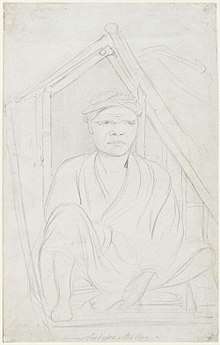Pobasso
Pobasso, also spelt Probasso or Pobassoo, was the chief of a division of the Makassan fleet of perahu in the waters between northern Australia and Indonesia in the late 1700s and early 1800s. The fleet harvested trepang, or sea cucumber, trading it to China.[1] Pobasso was a key informant on the early Makassan relationships with Australia's Indigenous peoples prior to European settlement.

Contact with Flinders
On his 1803 voyage mapping the coastline of Terra Australis, Captain Matthew Flinders came upon six perahu vessels on the 17 February at the English Company's Islands' Malay Road, north of Arnhem Land. Thinking they were Chinese pirates he approached with caution. Pobasso, who Flinders described as a "short, elderly man" and five other chiefs came aboard Finders's ship the Investigator, communicating through the ship's chef who was a Malay.[2] Flinders later went aboard Pobasso's vessel also.[3]
Pobasso educated Finders about their fleet. He said its commander-in-chief was a man named 'Salloo' and was owned by the 'Rajah of Boni'. It boasted separate divisions totaling 60 perahu and 1000 crew. Each perahu was 25 tons with a crew of 20 to 25 men.[3] He said that he had made at least six voyages to the Australian coast over 20 years and was the first to do so. They had no knowledge of any European settlement in Australia and upon Flinders telling him about Port Jackson, Pobasso's son took notes about the settlement in "foreign characters, writing from left to right".[3] He also claimed to never have seen another foreign ship in the waters of the northern Australian coastline.[2][4]
Pobasso's fleet had no charts nor were they able to make astronomical observations. They had no navigational tools other than a small compass. They carried a month's water supply in joints of bamboo as well as dried fish, coconuts, rice and poultry.[2] Flinders noted that Pobasso carried two small brass guns, obtained from the Dutch. The other chiefs were also armed, each carrying "a short dagger or cress".
Pobasso warned that his fleet "sometimes had skirmishes with the native inhabitants of the coast". He had formerly been speared in the knee, cautioning Flinders, ‘beware of the natives’.[3]
He was sketched by artist William Westall who was aboard the Investigator.[5]
Pobasso delayed his journey by a day to spend time with Flinders, accepting gifts of iron tools and a letter written in English to show to any other ships he might meet on his travels.[3]
Flinders named an island after Pobasso, Pobassoo Island.[3][6][7]
References in popular culture
A fictional representation of Pobasso features in Steven Marcuson's novel The Bunting Quest.[8]
References
- MacKnight, CC (1976). The Voyage to Marege: Macassan Trepangers in Northern Australia. Melbourne University Press. ISBN 0-522-84088-4.
- Lockwood, Douglas (1968). The Front Door: Darwin 1869-1969. Adelaide: Rigby Limited. ISBN 0727020250.
- Flinders, Matthew (1814). A Voyage to Terra Australis Vol 2 (Facsimile Edition, 1966 ed.). Pall Mall: G. And W. Nicol.
- Powell, Alan. Far Country: A short history of the Northern Territory. Melbourne Univer. Publishing. ISBN 9780522865738. Retrieved 7 January 2017.
- Westall, William. "The English Company's Islands, Probasso, a Malay chief [picture] / [William Westall]". Trove. National Library of Australia. Retrieved 7 January 2017.
- Middiman, Samuel; Westall, William (12 February 1814). "View of Malay Road, from Pobassoo's Island. [picture]". Trove. National Library of Australia. Retrieved 7 January 2017.
- "Pobassoo Inlet". Google Maps. Google. Retrieved 7 January 2017.
- Marcuson, Steven (2016). The Bunting Quest. Hybrid Publishers. ISBN 978-1-925272-15-4. Retrieved 7 January 2017.